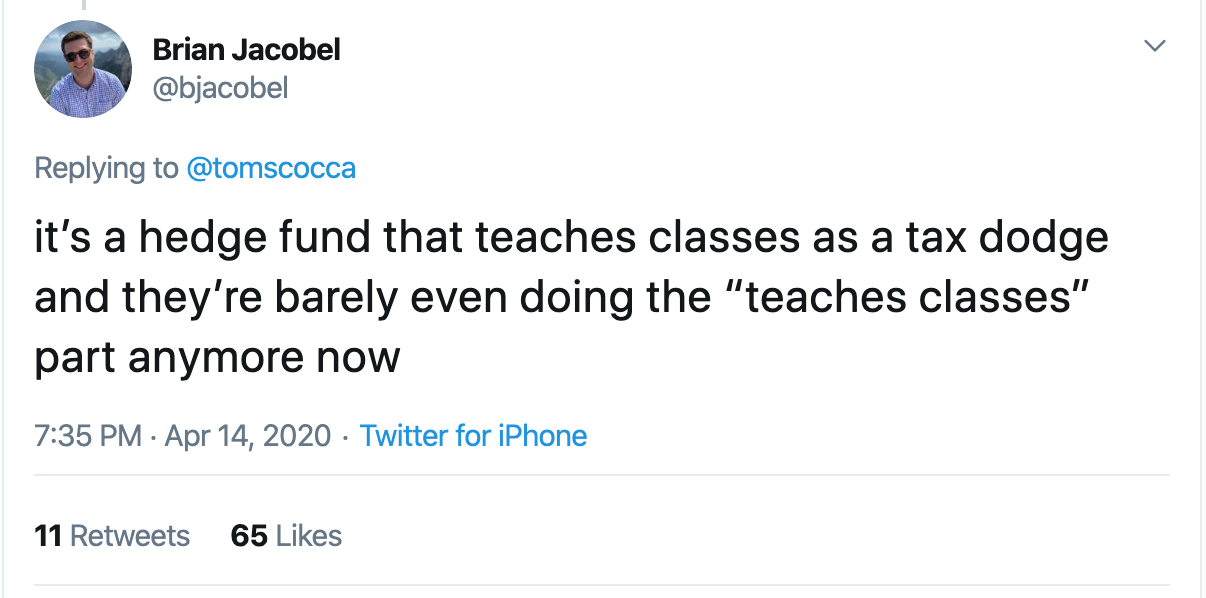prison will be the new college
welcome
to the first edition of Special Situations, the first newsletter to focus on markets defined by post-moral dynamics.
You can follow me on Twitter @thechadlin or sign up for my newsletter here.
interview
Note: Lightly edited by Preston Everblue’s Chief of Staff for clarity, length, and speed-reading.
And people, you know, they’ll admit that they missed out on Twitter, that they should have written the check, but you just don’t hear folks talking about how we all missed out on Death Row Records. We all did.
Chad Lin: Hi Preston, it’s great to have you as my inaugural interview. Thanks for hopping on Blue Jeans.
Preston Everblue: No problem Chad. After hearing about what you’re trying to do with Special Situations I was excited to get involved. Reframing assumptions about morally complex situations is key to growing the economy and unlocking human potential.
C: Agreed Preston. Let’s get started. Before we dive into Homeroom Homies, can you tell us a little bit about how you became interested in ed-tech and education finance?
P: Sure Chad. Up until mid-2014, I was an investor at Redford Associates, where I worked in the racial arbitrage group.
C: Racial arbitrage! Very hot topic right now in the post-moral investment community. Can you explain what that is?
P: Of course! So, one of Redford’s core investment theses is that you want to invest in things that black people are doing but white folks — and some other demographics — have not started doing yet.
Why? A historical survey using over 150 years of media and public records found that anything that is prevalent within the African-American community will become prevalent in white community once the expected cost — physical danger, reputational risk, etc — of participating in that activity equals the expected cost of participating in leisure activities enjoyed in the white community.
The classic example here, of course, is hip-hop. And people, you know, they’ll admit to missing out on Twitter, they’ll say they should have written the check, but you just don’t hear folks talking about how they missed out on Death Row Records. We all did.
C: You’re right. I’ve never heard that.
P: Exactly.
C: What about the Latinx community, the Asian community, other people of color? How do they fit into the model?
P: Great question Chad. I haven’t thought about that.
C: Myopic focus?
P: Exactly. Anyways, towards the end of my tenure, I started to think, what’s something that is more prevalent in the black community than the white community right now, but still resembles something white folks are already familiar with?
C: So you’re saying that prison, out of other potential racial arbitrage opportunities, is the way to go because it has similarities with an institution they have historically appreciated, but has recently degraded in value.
P: Exactly Chad. Think about all the parallels between prison and college. You’re going to have to bullet point these.
It costs about $40,000 per year.
Prison attendance is a powerful signaling mechanism that establishes credibility with potential employers.
The most successful prisoners build a strong network that they can tap after leaving to learn about commercial opportunities and share learnings.
Many folks have trouble finding jobs after leaving prison and end up coming back.
Prisoners with more money can get into comparatively better prisons — safer, etc.
“Clubs” and “rivalries” are an integral part of prison social life.
Similar naming conventions, i.e. [Location Name] State. In the weeds, but reduces transition costs, you know.
It’s easier to get into prison if you’re black or latino — or reframed, harder to get into prison if you’re white.
Like elite college athletes, the most promising prisoners are scouted from a young age. In addition, neither college athletes or prisoners are fairly compensated for their labor.
Legacy prisoners have an advantage in the admissions process — like college, more likely to get into a prison if one of your parents went.
It’s widely accepted that many universities exist primarily to generate returns for investors.

P: So I start thinking about this, and realize wow. Prison solves for college. You see, we have an institution that is struggling. Last year, outstanding student loan debt topped 1.5 trillion dollars.
Universities are struggling to modernize their curriculums, students struggling to find jobs after graduation — you’ve heard it all before. It’s a mess. But you know, the kids love it. And they and their families will pay tens of thousands of dollars a year for what amounts to a pretty poor user experience. So we have demand.
At the same time, it’s a bear market for incarceration. We’ve built all of these prisons Chad, and they’re leaking prisoners, slowly but surely. You have releases because of Coronavirus.
You have the decriminalization of marijuana and other drug offenses. You have a movement towards diverting folks from prison to house arrest. So we have supply.
So what we can do, is we can take this private prison real estate, and we can transform it into a transformative experience for ambitious students to prepare them for a 21st century workforce.
the business model
The TAM is huge Chad. It’s huge. I can’t emphasize this enough. I’m not sure whether it’s more accurate to say that the TAM has no limit or that the TAM is unaddressable, but it’s huge Chad. The TAM is huge.
C: This is thought provoking stuff Preston. Take me through the business model.
P: In brief: raise capital to purchase private prisons, fund ISAs to send kids to prison for four years, pay inmates to facilitate experiential learning for prisoners, “release” the students, and then collect on the ISA.
C: What kind of learning would the prisoners facilitate?
P: I can’t dive deep into curriculum or pedagogy, but think about it Chad.
If you want to excel at a Fintech or consulting firm after college, where are you going to learn more about complex markets and political economy than prison?
If you’re going to work in marketing or sales, where is a better place to learn about persuasion and hacking social dynamics than prison? Where is a better place to tactfully stand up for yourself in tense situations, or learn how to teach people the way to treat you?
C: It’s uniquely differentiated. It’s like living Extreme Economies instead of reading it.
P: Exactly.
C: So two questions. First, how do you get the money back? That’s a key implementation issue with ISAs that I don’t think has been solved. Second, how do you manage the optics, in terms of debt load — even if it isn’t debt — and defaults?
P: Great questions. First, just to remind your readers, an ISA — or Income Sharing Agreement — basically says hey, here’s some cash, you don’t owe us anything, just pay us a fixed percentage of your income for a fixed time period after you graduate. And if you don’t make above a minimum income, you don’t have to make payments.
So in terms of getting it back, we’re going to make each kid agree to let us monitor whatever bank account they use to receive paychecks.
C: You don’t see any optics issues with that?
P: Nope. This isn’t our idea. Leif Technologies, a leading ISA servicer, requires this. Second, for students where they’re not finding good jobs, we’re going to offer them a discounted rate to come back to the prison and re-skill for a discounted rate.
C: Worse comes to worse, you’ll have years of transaction history paired with four years of observational data.
P: Everything is worth something to someone, Chad.
You know, we can even see these becoming incubators of sorts.
C: Exactly. So you have what, 4 million or so kids turning 18 each year. And we’re going to set an income share for that 40K ISA that yields nice returns. Very nice. And then you have all of the data you’re collecting. At the same time, there isn’t even enough space to hold 4 million kids in our prisons — we only have like 1.5 million prisoners right now, right Preston? So where do these kids go? What’s the TAM?
P: We’re going to try to do some proofs of concepts in wings of private prisons that are sending people home for supervised release because of coronavirus. If those are successful, we should be able to raise capital to build more prisons. Or convert universities — think innovators like ASU — into prisons.
So with TAM, I mean. The TAM is at least 160 billion a year. 4 million kids a year times 40k. I mean it’s more, that’s reductive, but is it even worth modeling after 160 billion? Just give me the money.
The TAM is huge Chad. It’s huge. I can’t emphasize this enough. I’m not sure whether it’s more accurate to say that the TAM has no limit or that the TAM is unaddressable, but it’s huge Chad. The TAM is huge.
C: It is huge, Preston. Very big. What challenges are you working through right now?
P: The biggest one is actually whether we gender segregate. We’re probably going to let the kids choose, because there’s some research that says students learn better in single gender environments, so some folks may want that.
C: Very thoughtful, Preston. Well, thanks for the discussion. This is a really fascinating space you’ve found.
P: Thanks Chad. I agree. And it may sound crazy, but right now, you know how people say America’s universities are the envy of the world? I look forward to a day where America’s prisons are the envy of the world.
C: That would be something.
P: I’ll leave you with a Barack Obama quote.
“We have more work to do when more young black men languish in prison than attend colleges and universities across America.” President Barack Obama
Perhaps, this attitude is a solution chasing a problem.
in the news
Senior administration officials quietly urge President Trump to suspend calls for Chinese to “coronavirus reparations.”
Close aides sounded the alarm after prominent black conservatives Candace Owens and Kanye West told Trump China played role in transatlantic slave trade during a conference call.

attribution (redstate.com)
Concerns intensified after a DOJ memorandum assessed that narrowly tailored reparations program for African-Americans would
provide precedent for adversarial nation-states to pursue claims against the US government predicated on its failure to publicly disclose information relevant to international security. Without this flexibility, the US government may be forced to publicly disclose information that undermines US national security interests to shield the US government and senior government officials from potential civil liability.”
Thank you for reading. Next week I’ll be interviewing Sarah Bremer, founder of Shockly, an exciting entrant into the consumer health space.
If you enjoyed please subscribe and share with your friends and colleagues. Follow me @thechadlin



